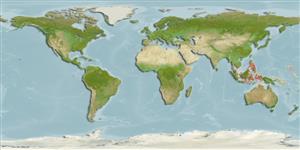>
Eupercaria/misc (Various families in series Eupercaria) >
Labridae (Wrasses) > Corinae
Etymology: Halichoeres: Greek, als, alis = salt + Greek, choiros = pig (Ref. 45335); hilomeni: Named for Dr. Vincent V. Hilomen of the University of the Philippines Los Baños in recognition of his efforts in obtaining collection and export permits and arranging the shipment of the type specimens to the authors..
More on authors: Randall & Allen.
Environment: milieu / climate zone / depth range / distribution range
ນິເວດວິທະຍາ
ສັດທະເລ ກ່ຽວກັນຫີນ; ລະດັບຄວາມເລິກ 1 - 3 m (Ref. 85096). Tropical
Western Central Pacific: Philippines and Malaysia.
ຂະໜາດ / ນ້ຳໜັກ / Age
Maturity: Lm ? range ? - ? cm
Max length : 9.6 cm SL ຕົວຜູ້/ບໍ່ມີເພດ; (Ref. 85096)
Short description
ສະລີລະວິທະຍາ | ການວັດແທກຮູບຮ່າງລັກສະນະພາຍນອກຂອງດິນ,ສັດ,ປາ…
ຄີ (ໜາມ)ແຂງຢູ່ຫຼັງປາ (ທັງໝົດ): 9; ຄີຫຼັງຂອງປາ (ຄີອ່ອນ) (ທັງໝົດ): 12; ຄີ(ໜາມ) ແຂງຢູ່ຄີກົ້ນປາ
ກຸ່ມປາກະດູກແຂງ
ຄວາມຖີ່ຂອງກຸ່ມຖ່າຍທອດພັນ
ປາທີ່ມີການເຄື່ອນຍ້າຍຈາກທະເລໄປຫານ້ຳຈືດ ແລະນ້ຳຈືດຫາທະເລ
ປາທີ່ມີການເຄື່ອນຍ້າຍຈາກທະເລແລະໄປໄຂ່ຢູ່ນ້ຳຈືດ
ຄີກົ້ນຂອງປາ
ສັດທີ່ມີກະດູກສັນຫັຼງ
ການຖ່າຍທອດທາງກຳມະພັນຈາກພໍ່ແມ່ຫາລູກ 3; ຄີກົ້ນຂອງປາ: 12; ສັດທີ່ມີກະດູກສັນຫຼັງ: 25. This species is characterized by the following: D IX,12; A III,12; pectoral rays 14; lateral-line scales 27; head naked but nape fully scaled; most scales of straight anterior part of lateral with a middle surface tubule forming 3 short branches ending in a pore, with the middle branch usually longest; suborbital pores 10-13; gill rakers 18-20; body depth 3.15-3.6 in SL; head length (HL) 2.9-3.0 in SL; snout length 2.85-3.25 in HL; dorsal spines progressively longer posteriorly, last 3 subequal, 2.85-3.4 in HL; caudal fin moderately rounded, 1.35-1.5 in HL; upper half of body dark brown, males with 5 narrow pale bars extending from base of dorsal fin; lower half of body pale brown, the centres of scales darker; a dark brown band from upper lip to lower half of orbit, extending posterior to eye, half as broad, to base of opercular flap; 3 narrow dark bars extending dorsally from postorbital band, the first black and vertical, just behind eye, the posterior 2 bands irregular; a boomerang-shaped dark brown band extending posteriorly from behind corner of mouth across cheek; fins are translucent pale yellowish, dorsal with a broad black band across middle of first 2 membranes; rest of fin with longitudinal rows of faint, dark-edged, pale spots (3 per membrane); anal fin with a row of faint, dark-edged, pale spots along base; caudal fin with faint transverse bands; paired fins pale, the pectorals with a triangular black spot dorsally on base, narrowing to a line across remainder of base; peritoneum dark brown (Ref. 85096).
Occurs in a sheltered habitat of mixed coral, algae, sand and gravel (Ref. 85096). Found in small groups or solitary (Ref. 90102).
Life cycle and mating behavior
ການຈະເລີນເຕັມໄວ | ການສືບພັນ | ການວາງໄຂ່ | ໄຂ່ | ຄວາມດົກຂອງໄຂ່ປາ | ຕົວອ່ອນ
Distinct pairing during breeding (Ref. 205).
Randall, J.E. and G.R. Allen, 2010. Two new labrid fishes of the genus Halichoeres from the East Indies. The Raffles Bull. Zool. 58(2):281-289. (Ref. 85096)
IUCN Red List Status (Ref. 130435)
Threat to humans
Harmless
Human uses
ຂໍ້ມູນຕື່ມອີກ
ຊື່ສາມັນຄຳສັບຄ້າຍຄືກັນການເຜົາໃໝ້ພະລັງງານໂດຍປ່ຽນທາດອາຫານໃນຮ່າງກາຍໃຫ້ກາຍເປັນຊີ້ນແລະໜັງຜູ້ລ້າການສຶກສາຜົນກະທົບຂອງສານຜິດທີ່ມີຜົນກະທົບຕໍ່ລະບົບນິເວດການສືບພັນການຈະເລີນເຕັມໄວການວາງໄຂ່ການສັງລວມການວາງໄຂ່ຄວາມດົກຂອງໄຂ່ປາໄຂ່Egg development
Age/Sizeການເຕີບໃຫຍ່Length-weightLength-lengthLength-frequenciesການວັດແທກຮູບຮ່າງລັກສະນະພາຍນອກຂອງດິນ,ສັດ,ປາ…ສະລີລະວິທະຍາຕົວອ່ອນການປ່ຽນແປງຂອງຕົວອ່ອນການທົດແທນທີ່ຄວາມອຸດົມສົມບູນBRUVS
ເອກະສານອ້າງອີງການລ້ຽງສັດນ້ຳຂໍ້ມູນການລ້ຽງສັດນ້ຳສາຍພັນກຳມະພັນElectrophoresesການຖ່າຍທອດທາງກຳມະພັນຈາກພໍ່ແມ່ຫາລູກພະຍາດການປຸງແຕ່ງNutrientsMass conversion
ຜູ້ຮ່ວມມືຮູບStamps, Coins Misc.ສຽງຫອຍມີພິດຊະນິດນຶ່ງທີ່ອາໄສໃນທະເລຄວາມໄວປະເພດການລອຍເນື້ອທີ່ເຫືອກOtolithsສະໝອງວິໄສທັດ
ເຄື່ອງມື
Special reports
Download XML
ແຫຼ່ງອີນເຕີເນັດ
Estimates based on models
Preferred temperature (Ref.
123201): 28.5 - 29.3, mean 28.8 °C (based on 489 cells).
Phylogenetic diversity index (Ref.
82804): PD
50 = 0.5000 [Uniqueness, from 0.5 = low to 2.0 = high].
Bayesian length-weight: a=0.00955 (0.00451 - 0.02020), b=3.09 (2.92 - 3.26), in cm total length, based on LWR estimates for this Genus-body shape (Ref.
93245).
ຊັ້ນເຂດຮ້ອນ (Ref.
69278): 3.4 ±0.5 se; based on size and trophs of closest relatives
Fishing Vulnerability (Ref.
59153): Low vulnerability (10 of 100).
